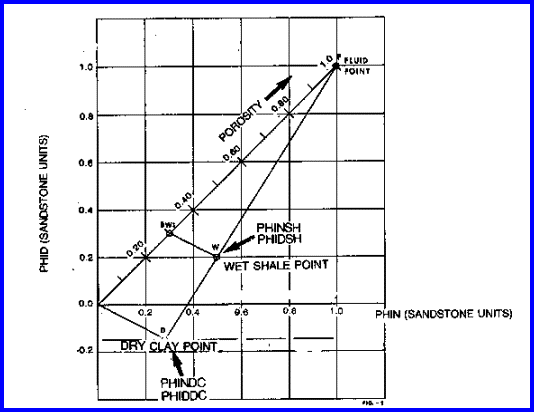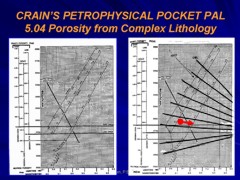|
 Bulk Volume Water (Dual Water) Model
Bulk Volume Water (Dual Water) Model
The bulk volume water solution is an alternate
density neutron method which partitions the water in the
formation into the free water in the pores and the bound
water in the shale. Water saturation is obtained from the
ratio of free water to effective pore volume.
This
is another version of the Shaly Sand Models
and suffers all the same problems as other shaly sand models,
particularly the problem of heavy minerals. Go
HERE to read the warnings and cures.
A superior model that avoids these problems is the
Shale Corrected Density Neutron Complex
Lithology Crossplot Method. The Meta/Kwik spreadsheet for this
model is available at
Downloads and Spreadsheets.
 Bulk Volume Water (Dual
Water)
Bulk Volume Water (Dual
Water)
A major assumption required is the value of the apparent density
log porosity of dry clay in the shale matrix (PHIDDC). This is
often a negative number because the dry clay is more dense (lower
porosity) than pure quartz.
Calculate neutron log dry clay point from density dry clay value,
1: PHINDC = 1.00 - (1.00 - PHIDDC ) * (1.00 - PHINSH) / (1.00
- PHIDSH)
Calculate bulk volume of bound water in shale.
2: BVWSH = (PHINDC * PHIDSH - PHIDDC * PHINSH) / (PHINDC - PHIDDC)
Calculate total porosity, also called total bulk volume of water.
3: PHIt = (PHINDC * PHID - PHIDDC * PHIN) / (PHINDC - PHIDDC)
Calculate effective porosity.
4: PHIbvw = PHIt - Vsh * BVWSH
Where:
BVWSH = bulk volume of water attached to 100% shale (fractional)
PHIbvw = effective porosity from BVW method (fractional)
PHID = density log reading (fractional)
PHIDDC = density dry clay point (fractional)
PHIDSH = density shale point (fractional)
PHIN = neutron log reading (fractional)
PHINDC = neutron dry clay point (fractional)
PHINSH = neutron shale point (fractional)
PHIt = total porosity (fractional)
Vsh = shale volume (fractional)
 COMMENTS:
COMMENTS:
The formulae are shown graphically in below.

Chart for Dual Water Porosity Model - note that Dry Clay has a
negative density porosity. The dry clay point is found
from an extrapolation from the water point through the wet shale
point down to the dry clay density (which is based on the clay
mineral present in the shaly sand).
This
method is mathematically similar to the shaly sand crossplot method.
If matrix offset is required for heavy minerals, apply the offset
to all neutron and density values including shale points first,
then use the above equation. The method is also called the dual
water method and is the basis of many wellsite and office computer
programs.
Nothing special is done in gas zones, as the values computed for
PHIt and PHIe are reasonable even if gas crossover occurs.
 RECOMMENDED
PARAMETERS:
RECOMMENDED
PARAMETERS:
The usual value for PHIDDC is in the range of minus 0.11 to minus
0.15. It cannot be picked by observation of logs or crossplots.
It can be calculated from:
5:
PHIDDC = (DENSDC - DENSW) / (DENSMA - DENSW).
 NUMERICAL EXAMPLE:
NUMERICAL EXAMPLE:
1. Assume data for Sand "D".
PHID = 0.12
PHIN = 0.28
DENSMA = 2650 kg/m3 (no offset)
PHIDSH = 0.03
PHINSH = 0.30
Vsh = (0.28 - 0.12 ) / (0.30 – 0.03) = 0.59
Select PHIDDC = - 0.13 by calculating dry clay porosity from dry
clay density,
PHINDC = 1.00 - (1.00 - (- 0.13)) * (1.00 - 0.30) / (1.00 - 0.03)
= 0.184
BVWSH = (0.184 * 0.03 - (-0.13) * 0.30) / (0.184 - (-0.13)) =
0.142
PHIt = (0.184 * 0.12 - (-0.13) * 0.28) / (0.184 - (-0.13)) = 0.186
PHIbvw = 0.186 - 0.59 * 0.14 = 0.103
|



